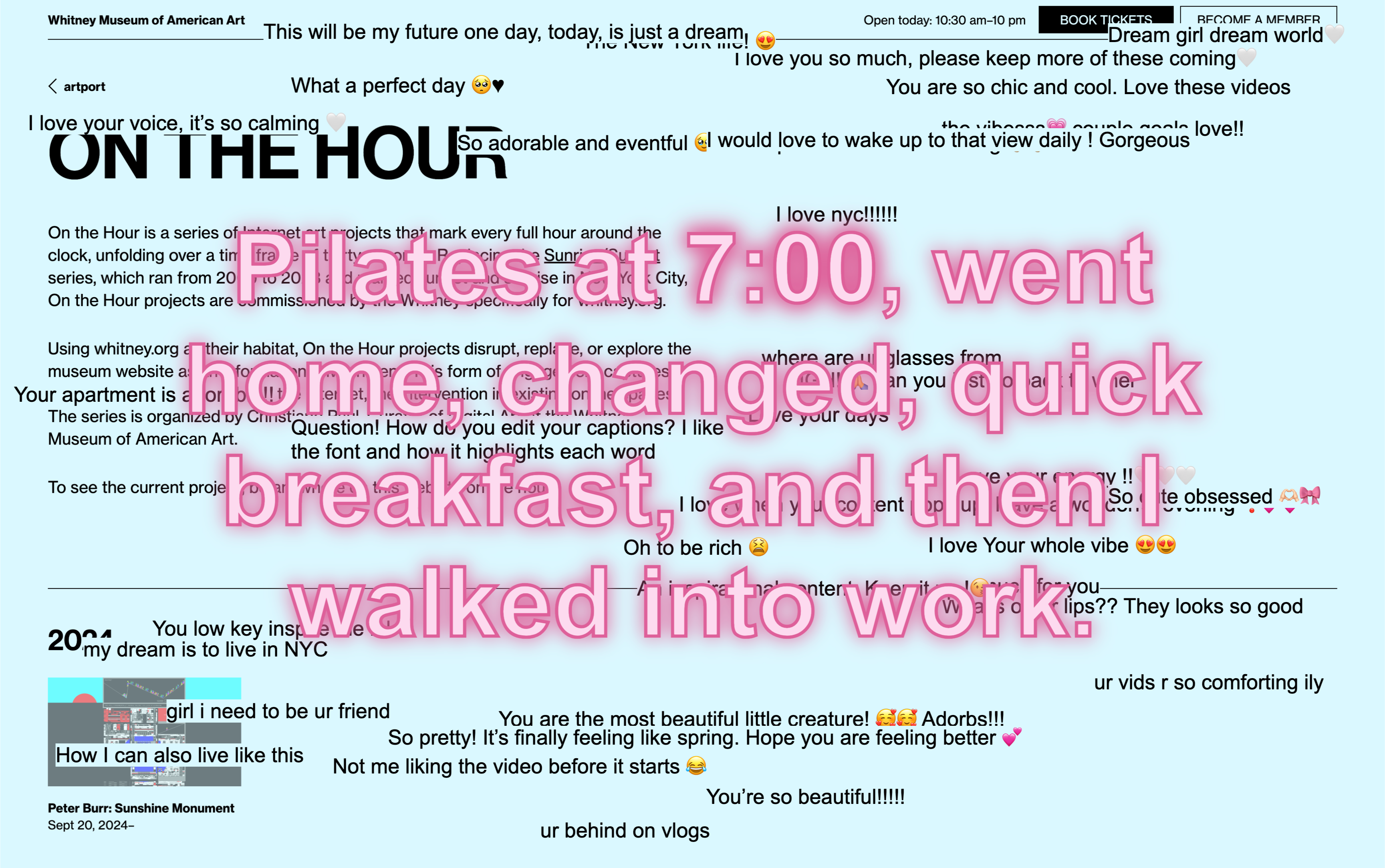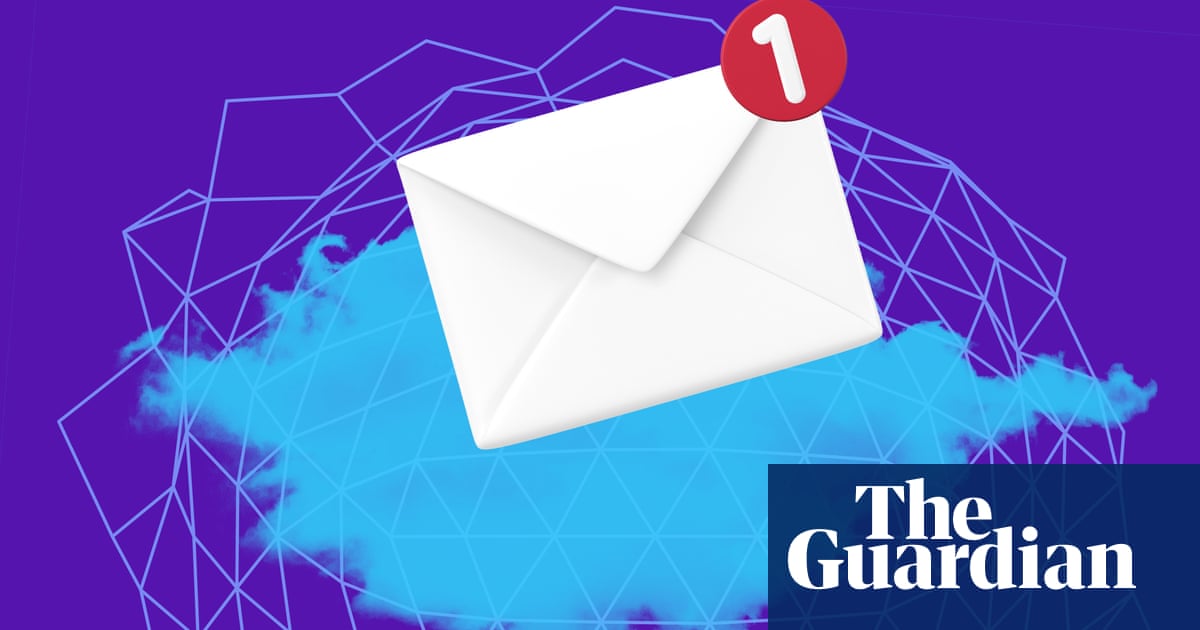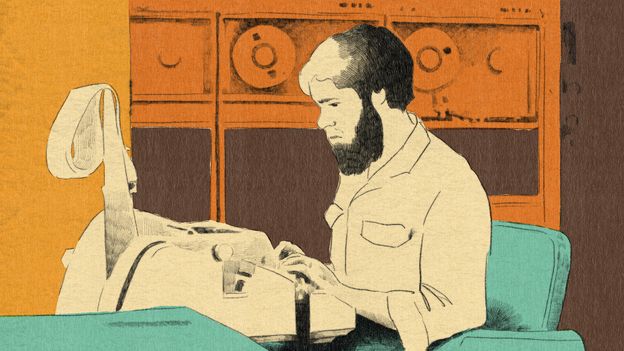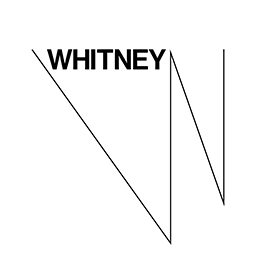This week's best things
A site-specific digital exhibition at The Whitney, finding Twitter users on Bluesky, what makes a good newsletter, Claude takes control of your computer, the start of the internet, looking back at Wired's first website, changes at Google, an analysis of Meta, Courses from Spotify

A Realistic Day In My Life Living In New York City
A new text-based, digital exhibition which is on display on all of The Whitney's digital estate (website, in-gallery screens, etc).
It draws from thousands of TikTok posts about life in New York.
"The artist excerpted text mentioning specific hours of the day — for example 8 am, 11 pm — from thousands of publicly posted TikTok videos, stripping them of all visual elements to highlight the “day in my life” genre’s method of storytelling. At the top of every hour, a quote from a “day in my life in New York City” video referencing the specific hour appears in large font size on whitney.org, followed by a stream of animated responses from the source videos’ comment section."
The artist talked a bit about the work that went into the exhibition in this short thread on X/Twitter.

Bluesky Follower Bridge
A Google Chrome extension that claims to help you find and follow the people on Bluesky that you followed on Twitter, which is very useful (I've used it, it's a little fiddly and slow, but it works) if you want to escape the Twitter/X hellscape.
Although as a few people mention in the reviews, use it while you can as Elon will no doubt clamp down on this sort of thing as soon as he realises people are using it.
What makes a good newsletter?
At the risk of getting too meta, this is an interesting roundtable with five writers about what they think makes a good newsletter.
"There’s a lot of noise around the format; everyone is joining Substack or launching their own multi-platform solo creator brand. But there’s very little discourse or criticism about this type of content. It’s hard to find good newsletters and it’s hard to find good thinking specifically about newsletters: their writing, their editorial choices, their presentation. So we gathered some smart friends to fill in the gap and discuss the subject over email."
The tl;dr is 'it depends', and it was interesting to see the (often wildly divergent) reasons why people sign up to newsletters and what they look for in terms of tone, format, and content.
"for the most part, I think the current Substack model of 1-2 posts/week drives most of us (and I definitely count myself as part of this) to push out the most harried, half-edited demi-thought ASAP in hopes of making readers feel like they're getting their money's worth, wordcount-wise. It's a looser, voicier writing more like what you'd encounter on Twitter or in blogland, but it's not always "interesting writing" per se. "

Anthropic Wants Its AI Agent to Control Your Computer
The most recent exciting/terrifying (delete as applicable) AI development was Anthropic's announcement that Claude can now carry out computer tasks.
"Anthropic, a high-flying competitor to OpenAI, announced today that it has taught its AI model Claude to do a range of things on a computer, including search the web, open applications, and input text using the mouse and keyboard."
This is a good long read from Ethan Mollick which describes what this is like to engage with in practice.
"Normally, you interact with an AI through chat, and it is like having a conversation. With this agentic approach, it is about giving instructions, and letting the AI do the work. It comes back to you with questions, or drafts, or finished products while you do something else. It feels like delegating a task rather than managing one.
As one example, I asked the AI to put together a lesson plan on the Great Gatsby for high school students, breaking it into readable chunks and then creating assignments and connections tied to the Common Core learning standard. I also asked it to put this all into a single spreadsheet for me. With a chatbot, I would have needed to direct the AI through each step, using it as a co-intelligence to develop a plan together. This was different. Once given the instructions, the AI went through the steps itself: it downloaded the book, it looked up lesson plans on the web, it opened a spreadsheet application and filled out an initial lesson plan, then it looked up Common Core standards, added revisions to the spreadsheet, and so on for multiple steps. The results are not bad (I checked and did not see obvious errors, but there may be some - more on reliability later int he post). Most importantly, I was presented finished drafts to comment on, not a process to manage. I simply delegated a complex task and walked away from my computer, checking back later to see what it did (the system is quite slow)."


Concerned about your data use? Here is the carbon footprint of an average day of emails, WhatsApps and more
Technology, and specifically the internet, uses a lot of energy. But there is still limited awareness and understanding of just how much day-to-day digital use contributes to increasing energy demands, and in turn carbon emissions.
This piece in the Guardian is a good illustration of just how much digital stuff is embedded in the daily rhythms of normal life in the west.
"All those emails and videos and games don’t just appear on our screens by magic. Everything we do digitally involves the vast transfer of data through the internet from one place to another, brokered through datacentres. Datacentres are vast premises full of computer servers that store data. The idea behind them is to reduce what the data industry calls “latency”, the time between you typing in a web address or clicking on an app button, and the content you are requesting being delivered to you. Everything on the internet, every link you click, every video you watch, is physically stored in a datacentre somewhere."
However the piece also does a good job of highlighting just how vague the measuring of this usage still is, getting to actual, reliable numbers is an imprecise science.
“It’s incredibly hard to figure out that information,” says de Vries.
In the absence of reliable figures from the companies themselves, educated guesses are often all we can rely on. Case in point: estimates of the proportion of world energy use that the internet makes up range from 3.7% to 10%, depending on who is counting. One estimate by Zero Waste Scotland suggests all our online activity generates an average of 8.62kg of CO2 a week (about 448kg a year), or about 30 miles in an average-sized petrol car. But a German estimate (which also includes the emissions created by the production digital devices themselves) says we expend around twice that, roughly 850kg a year.

'We were just trying to get it to work': The failure that started the internet
If you've been reading this newsletter for more than a few weeks you'll know I love sharing things about the history of the internet.
On that subject, this is a great article from the BBC interviewing Charley Kline and Bill Duvall who both worked on Arpanet in the 1960s (the technology developed for Arpanet would later become part of the technical foundations of the internet).
"Kline sat at his keyboard between the lime-green walls of UCLA's Boelter Hall Room 3420, prepared to connect with Duvall, who was working a computer halfway across the state of California. But Kline didn't even make it all the way through the word "L-O-G-I-N" before Duvall told him over the phone that his system crashed. Thanks to that error, the first "message" that Kline sent Duvall on that autumn day in 1969 was simply the letters "L-O".
They got their connection up and running about an hour later after some tweaks, and that initial crash was just a blip in an otherwise monumental achievement. But neither man realised the significance of the moment. "I certainly didn't at that time," Kline says. "We were just trying to get it to work."

‘We Were Wrong’: An Oral History of WIRED’s Original Website
A little more about 'the old net' (although from not quite as long ago as 1969).
This is a fun read from the team at Wired as they look back 30 years to the first ever Wired website.
"Exactly 30 years ago this month, we let the genie out of the bottle when we launched HotWired, our first website—and one of the first media websites ever. With wit and vitality, HotWired covered a new world that traditional media ignored: thrill sports, cocktails, integrative medicine, DJ culture. It was the first website ever to cover a presidential election. It ushered newcomers online with Web 101. It introduced Suck! (Look it up.) HotWired was improv, a startup, an acid test. And it was the web’s keystone.
So dial up 1994. “Online” is, to all but a culty few, a vast tundra of nothingness. Those culty few? A clique of self-styled clairvoyants holed up in a post-punk loft in San Francisco, awash in Ethernet cable, psychedelics, and a near-erotic mania for this thing called cyberspace …"

Requiem for Raghavan
Ed Zitron looks at Google's ongoing woes, and the role that Prabhakar Raghavan has played in them.
"Prabhakar Raghavan was made Head of Search a little over a year later in June 2020, and it's pretty obvious how big a decline Google Search has taken since then. Results are filled with Search Engine Optimized spam, ads and sponsored content are bordering on indistinguishable from regular results, and the disastrous launch of Google's AI-powered "summaries" produced results that ranged from hilarious to actively life-threatening. [...]
The chart tells another story — that this reckless and desperate move only worked for a little bit before growth began to slow again. Recklessness and desperation begets only more recklessness and desperation, and you’ll note that Google’s aggressive push into AI followed its dismal Q4 2022 quarter, where it nearly fell into negative growth (and when you factor inflation, it did).
If you’ll forgive the mixed metaphors, Google has essentially killed its golden goose — search — and is now in the process of pawning its eggs to buy decidedly non-magical beans, by which I mean data centers and GPUs, with Google increasing its capital expenditures in the financial year 2024 to $50 billion, equivalent to nearly double its average capital expenditures from 2019 to 2023."

Meta's AI Abundance
The latest article from Ben Thompson is ostensibly a very bullish take on why you should buy Meta stock.
But it also contains an interesting analysis of some of the changes Meta have made to their adtech in recent years. Whether you love or hate this technology, it's ubiquitous and is still responsible for most of the money that flows around the internet economy (for now). So it's (I think) helpful to have at least a passing understanding of how it works, and what is changing.
Almost every word in the section I've included below is symptomatic of what I think is wrong with the internet and digital marketing in 2024. But it's also a good demonstration of why companies like Meta will continue to invest in AI, and why advertisers will continue spending money advertising on Meta's products.
"Make no mistake, a lot of these kinds of companies were killed by ATT; the ones that survived, though, emerged into a world where no one other than Meta — thanks in part to a massive GPU purchase the same month the company reached its most-recent stock market nadir — had the infrastructure to rebuild the type of ad system they depended on. This rebuild had to be probabilistic — making a best guess as to the right target, and, more confoundingly, a best guess as to conversion — which is only workable with an astronomical amount of data and an astronomical amount of infrastructure to process that data, such that advertisers could once again buy based on promised results, and have those promises met.
Now into this cauldron Meta is adding generative AI. Advertisers have long understood the importance of giving platforms like Meta multiple pieces of creative for ads; Meta’s platform will test different pieces of creative with different audiences and quickly hone in on what works, putting more money behind the best arrow. Generative AI puts this process on steroids: advertisers can provide Meta with broad parameters and brand guidelines, and let the black box not just test out a few pieces of creative, but an effectively unlimited amount. Critically, this generative AI application has a verification function: did the generated ad generate more revenue or less? That feedback function, meanwhile, is data in its own right, and can be leveraged to better target individuals in the future."

Courses on Spotify
This launched earlier this year but I was reminded about it this week because Spotify are making their Courses free until the end of November.
Here's the original press release from March 2024:
"Today we’re launching a test for video-based courses on Spotify in the U.K. We’ve partnered with educational tech companies including BBC Maestro, PLAYvirtuoso, Skillshare, and Thinkific to bring video content directly to Spotify users.
U.K. users will now find video courses for purchase alongside their favorite music, podcasts, and audiobooks. The content for courses on Spotify covers a variety of topics categorized into four main themes: make music, get creative, learn business, and healthy living, giving listeners an abundance of options to expand their knowledge.
“Testing video courses in the U.K. allows us to explore an exciting opportunity to better serve the needs of our users who have an active interest in learning,” said Babar Zafar, VP Product Development at Spotify. “Many of our users engage with podcasts and audiobooks on a daily basis for their learning needs, and we believe this highly engaged community will be interested in accessing and purchasing quality content from video course creators."
It's a bit of a strange expansion/experiment that I don't necessarily see a huge amount of mileage in for Spotify, but it's interesting to see the things they're looking into to try and build (and lock-in) new audiences and open new sources of revenue (the Courses are usually offered as a paid extra on top of any premium subscription you're already paying for).

This week's consumption
I have been in the UK this week visiting my new nephews (newphews?) so I haven't read or watched as many things as usual.
I'm (re)reading A Prayer for Owen Meany by John Irving which was originally recommended to me by my friend Marc, it was his favourite book.
I also enjoyed this track from King Creosote, And The Racket They Made, and I revisited this from Guillemots, Redwings.








